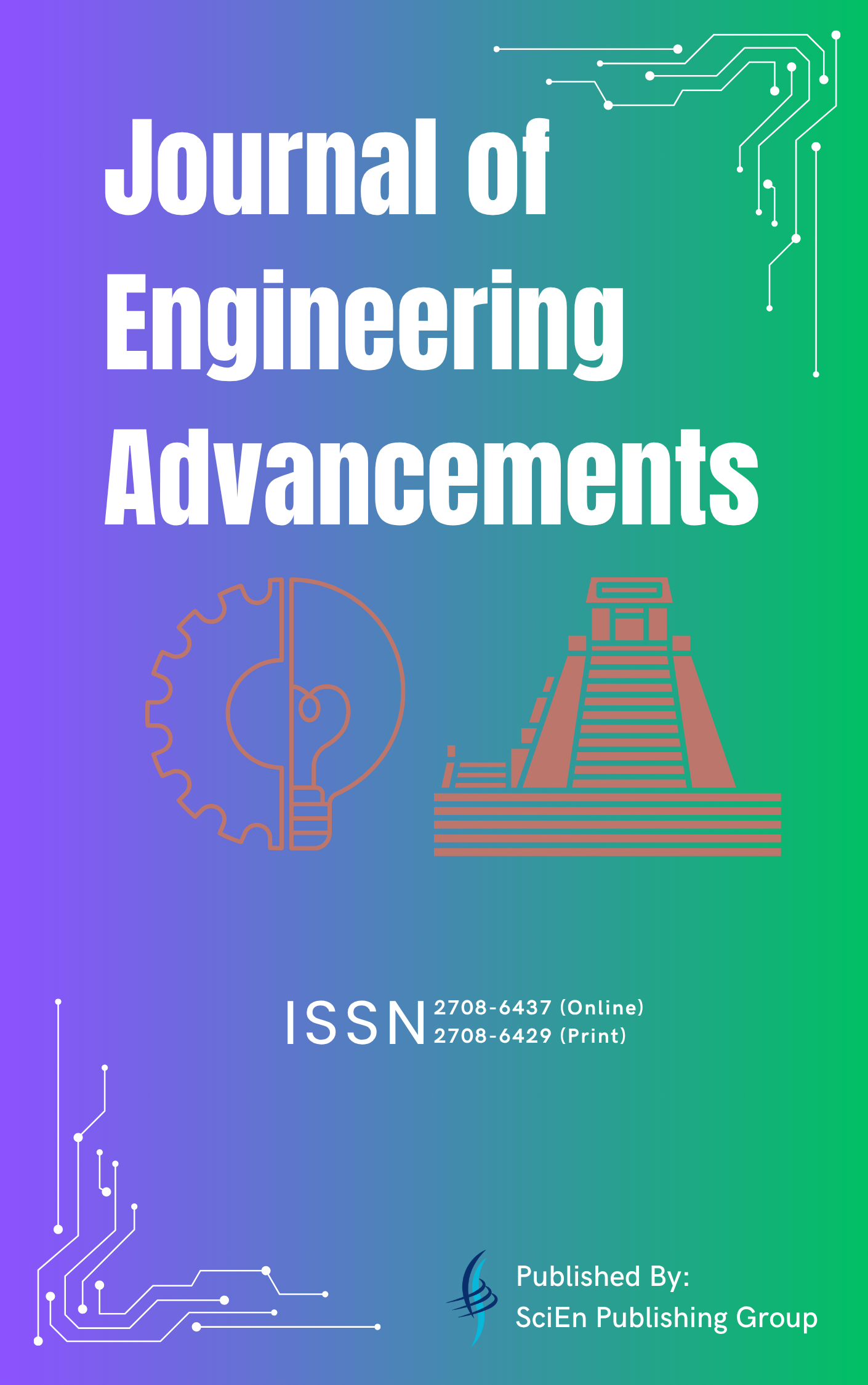Heat Transfer and Fluid Flow Analysis in a Corrugated Plate Heat Exchanger
DOI:
https://doi.org/10.38032/scse.2025.1.20Keywords:
Corrugated, Nanofluid, Nusselt number, Heat transfer coefficient, Reynolds numberAbstract
The corrugated plate heat exchangers have some significant benefits over orthodox heat exchangers due to easy maintenance and assembly-disassembly capability. This type of heat exchanger usually focuses on improving geometry by increasing the surface area in a heat exchanger and the heat transfer rate from plate to fluid. It works in an efficient manner for both single-phase and two-phase flow. In this study, the performance of a modified corrugated plate heat exchanger was studied numerically using ANSYS- Fluent 20R1. A transient, pressure-based model was selected for the analysis. For the turbulence model, k-ω SST was chosen. A nanofluid, base fluid of water containing nanoparticles of a metallic oxide (Al2O3) was used to enhance thermal conductivity. A wide range was taken in account with regard to Reynolds numbers (1000-12000). The effects of nanofluid on Nusselt number and Heat transfer coefficient were studied for the volume fraction of 0.2-2. The temperature distribution at different volume fractions inside the heat exchanger was also studied. At the hot outlet, temperature increases; at the cold outlet, temperature decreases with the increase in Reynolds number. Although the heat transfer coefficient was increased with the increase of volume fraction of Al2O3 while the surface Nusselt number decreased with the increase of volume fraction. The lowest heat transfer coefficient was found to be 12605.46 W/m2K for volume fraction 0.2 and the highest heat transfer coefficient was found to be 13017.43 W/m2K for the volume fraction 2.0. On the other hand, for the surface Nusselt number, the maximum value was found to be 199.5 for volume fraction 0.2 and the minimum value was found to be 122.16 for volume fraction 2.0.
Downloads
Downloads
References
[1] A. Jokar and S. P. O'Halloran, "Heat transfer and fluid flow analysis of nanofluids in corrugated plate heat exchangers using computational fluid dynamics simulation," Journal of Thermal Science and Engineering Applications, vol. 5, no. 1, p. 011002, 2013. DOI: https://doi.org/10.1115/1.4007777
[2] M. Pantzali, A. Kanaris, K. Antoniadis, A. Mouza, and S. Paras, "Effect of nanofluids on the performance of a miniature plate heat exchanger with modulated surface," International Journal of Heat and Fluid Flow, vol. 30, no. 4, pp. 691-699, 2009. DOI: https://doi.org/10.1016/j.ijheatfluidflow.2009.02.005
[3] M. Pantzali, A. Mouza, and S. Paras, "Investigating the efficacy of nanofluids as coolants in plate heat exchangers (PHE)," Chemical Engineering Science, vol. 64, no. 14, pp. 3290-3300, 2009. DOI: https://doi.org/10.1016/j.ces.2009.04.004
[4] A. K. Santra, S. Sen, and N. Chakraborty, "Study of heat transfer due to laminar flow of copper-water nanofluid through two isothermally heated parallel plates," International journal of thermal sciences, vol. 48, no. 2, pp. 391-400, 2009. DOI: https://doi.org/10.1016/j.ijthermalsci.2008.10.004
[5] K. S. Hwang, S. P. Jang, and S. U. Choi, "Flow and convective heat transfer characteristics of water-based Al2O3 nanofluids in fully developed laminar flow regime," International journal of heat and mass transfer, vol. 52, no. 1-2, pp. 193-199, 2009. DOI: https://doi.org/10.1016/j.ijheatmasstransfer.2008.06.032
[6] S. E. B. Maı̈ga, C. T. Nguyen, N. Galanis, and G. Roy, "Heat transfer behaviours of nanofluids in a uniformly heated tube," Superlattices and Microstructures, vol. 35, no. 3-6, pp. 543-557, 2004. DOI: https://doi.org/10.1016/j.spmi.2003.09.012
[7] R. K. Ajeel et al., "Turbulent convective heat transfer of silica oxide nanofluid through corrugated channels: An experimental and numerical study," International Journal of Heat and Mass Transfer, vol. 145, p. 118806, 2019. DOI: https://doi.org/10.1016/j.ijheatmasstransfer.2019.118806
[8] K. Wongcharee and S. Eiamsa-ard, "Heat transfer enhancement by using CuO/water nanofluid in corrugated tube equipped with twisted tape," International Communications in Heat and Mass Transfer, vol. 39, no. 2, pp. 251-257, 2012. DOI: https://doi.org/10.1016/j.icheatmasstransfer.2011.11.010
[9] M. Lazarevikj, R. V. Filkoski, and Z. Markov, "CFD analysis of heat transfer and fluid flow in plate heat exchanger with nanofluid," in Conference Paper, July, 2018.
[10] Y. He, Y. Men, Y. Zhao, H. Lu, and Y. Ding, "Numerical investigation into the convective heat transfer of TiO2 nanofluids flowing through a straight tube under the laminar flow conditions," Applied Thermal Engineering, vol. 29, no. 10, pp. 1965-1972, 2009. DOI: https://doi.org/10.1016/j.applthermaleng.2008.09.020
[11] A. D. Sommers and K. L. Yerkes, "Experimental investigation into the convective heat transfer and system-level effects of Al2O3-propanol nanofluid," Journal of Nanoparticle Research, vol. 12, no. 3, pp. 1003-1014, 2010. DOI: https://doi.org/10.1007/s11051-009-9657-3
[12] B. Saleh and L. S. Sundar, "Experimental study on heat transfer, friction factor, entropy and exergy efficiency analyses of a corrugated plate heat exchanger using Ni/water nanofluids," International Journal of Thermal Sciences, vol. 165, p. 106935, 2021. DOI: https://doi.org/10.1016/j.ijthermalsci.2021.106935
[13] Q. Hu, X. Qu, W. Peng, and J. Wang, "Experimental and numerical investigation of turbulent heat transfer enhancement of an intermediate heat exchanger using corrugated tubes," International Journal of Heat and Mass Transfer, vol. 185, p. 122385, 2022. DOI: https://doi.org/10.1016/j.ijheatmasstransfer.2021.122385
[14] M. Zaboli, S. Saedodin, S. S. Mousavi Ajarostaghi, and M. Nourbakhsh, "Numerical evaluation of the heat transfer in a shell and corrugated coil tube heat exchanger with three various water‐based nanofluids," Heat Transfer, vol. 50, no. 6, pp. 6043-6067, 2021. DOI: https://doi.org/10.1002/htj.22161
[15] F. R. Menter, "Two-equation eddy-viscosity turbulence models for engineering applications," AIAA journal, vol. 32, no. 8, pp. 1598-1605, 1994. DOI: https://doi.org/10.2514/3.12149
Published
Conference Proceedings Volume
Section
License
Copyright (c) 2025 Sukanto Biswas, Mohammad Ilias Inam, Prokash Chandra Roy (Author)

This work is licensed under a Creative Commons Attribution 4.0 International License.
All the articles published by this journal are licensed under a Creative Commons Attribution 4.0 International License

